Most Endangered Primates
Primates play a crucial role in maintaining the diversity of the planet and unquestionably help maintain the health of the global ecology. Unfortunately, the majority of primate species are on the list of endangered species due to the sharp decline in their population.
Large-scale habitat loss, particularly from the burning and clearing of tropical forests, food hunting, and the illegal wildlife trade, is eliminating our closest living relatives.
60% of the primate species are on the verge of extinction, and 75% of their populations are dramatically decreasing.
That’s according to the most recent edition of “Primates in Peril: The World’s 25 Most Endangered Primates”, compiled by the primate specialist group The International Union for the Conservation of Nature (IUCN), the Bristol Zoological Society (BZS), Global Wildlife Conservation (GWC), the International Primatological Society (IPS), Species Survival Commission (SSC), and Conservation International scientists just updated their list of the 25 most endangered primates on Earth (CI). They update it every two years.
The rising threat to primates is serious for the entire world. Therefore, the only important action that can prevent them from going extinct in the near future is to conserve them right away.
Here’s the list of the Top 25 most endangered primates –
1. Lake Alaotra Gentle Lemur
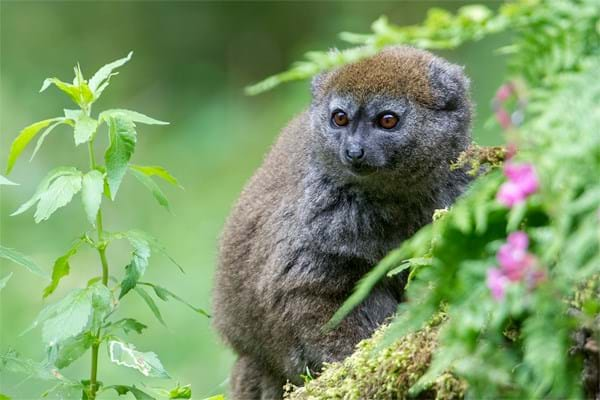
The Lac Alaotra Bamboo Lemur, also known as the highly endangered Lake Alaotra Gentle Lemur, is referred to as the bandro by locals. The only primate that only inhabits wetlands, this lemur is found in Madagascar’s Lake Alaotra marsh, which is fading fast.
It feeds on papyrus reeds specifically and doesn’t eat bamboo. It typically has a brownish-gray appearance with a body and tail length of 40 cm each. It is between 1.1 and 1.4 kilograms in weight.
Lemur hunting for food has been prohibited thanks to conservation efforts, but the Lake Alaotra marshes’ agricultural use still threatens the species’ population.
Scientific Name
Hapalemur alaotrensis
Current Population
A 2018 IUCN estimate put the total number of Lac Alaotra lemurs at 2,500.
Reasons Why They are Endangered
The main factors that have led to the critically endangered status of the Alaotran gentle lemur are hunting for food and a pet, destroying habitat, and burning the marshland.
Status of conservation
The International Union for Conservation of Nature lists this primate as a critically endangered species.
| Scientific Name | Hapalemur alaotrensis |
| Current Population | A 2018 IUCN estimate put the total number of Lac Alaotra lemurs at 2,500. |
| Reasons Why They are Endangered | The main factors that have led to the critically endangered status of the Alaotran gentle lemur are hunting for food and a pet, destroying habitat, and burning the marshland. |
| Status of Conservation | The International Union for Conservation of Nature lists this primate as a critically endangered species. |
2. James’ Sportive Lemur
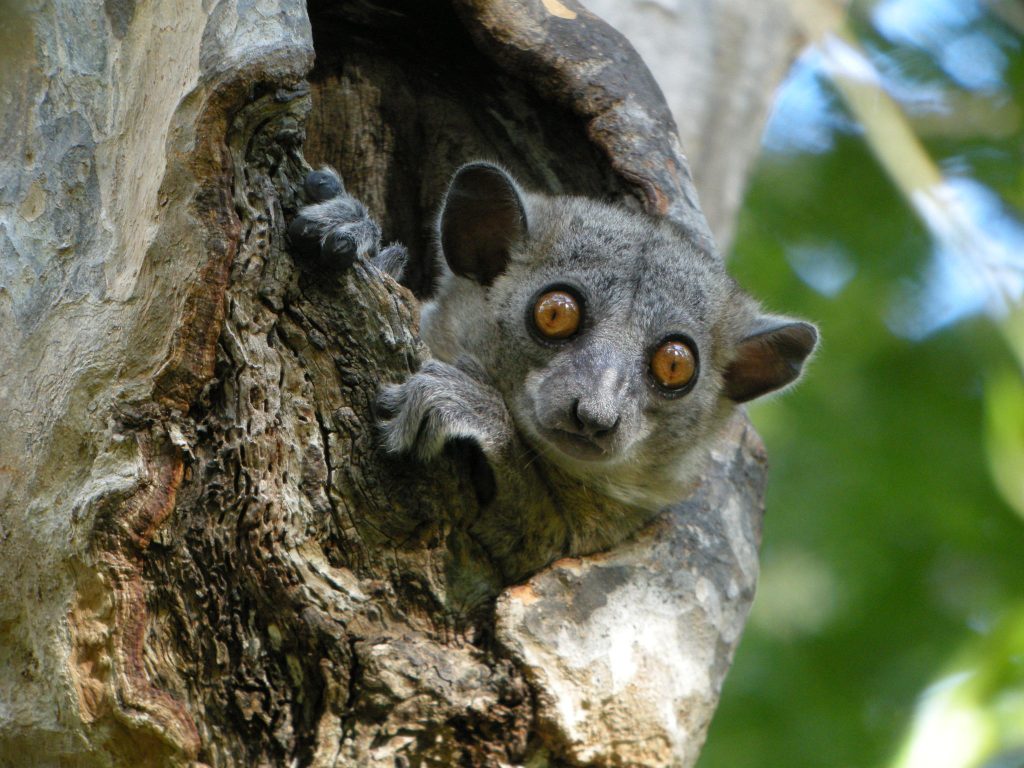
The Manombo Special Reserve area in southeast Madagascar is home to the James’ Sportive Lemur. In forest reserves, there are currently two populations. Lemurs are taken out of their burrows by hunters using traps and cutting down the trees they live in.
The primary and secondary lowland forests of southeast Madagascar are home to Jame’s sportive lemur.
This lemur is 60 to 67 cm long, with a tail that is between 28 and 32 cm in length, making it one of the larger sportive lemurs.
Scientific Name
Lepilemur jamesorum
Current Population
Only 1,386 Manombo sportive lemurs are left in existence,
Reasons Why They Are Endangered
Their critically endangered position and an estimated population of 1,386 individuals were caused by deforestation, pet trading, and hunting for bushmeat.
Status of Conservation
The IUCN study states that James’ Sportive Lemur is a critically endangered primate.
| Scientific Name | Current Population | Reasons for Endangerment | Conservation Status |
|---|---|---|---|
| Lepilemur jamesorum | 1,386 | Deforestation, pet trading, hunting for bushmeat | Critically Endangered |
3. Tana River Red Colobus
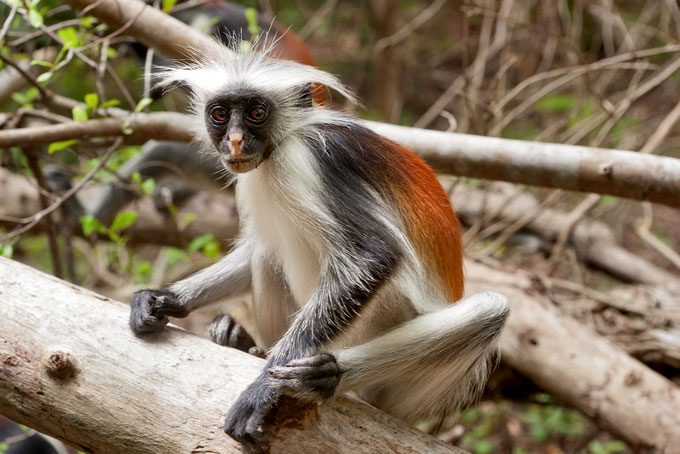
This red colobus lives along the Tana River in northern Kenya. Its tail is more than 31 inches long, and its body is almost 2 feet long. This critically endangered monkey has a red or dark red coat. In northern Kenya, close to the Tana River, the red colobus has its homes.
This species’ population has declined as a result of the development of hydroelectric dams and the region’s quickly expanding human population. The region’s vegetation is changing as a result of the dam construction, which lowers the availability of suitable food.
Scientific Name
Piliocolobus rufomitratus
Current Population
There are less than 1,000 individuals left, according to the IUCN, making it critically endangered.
Reasons Why They Are Endangered
The development of hydropower dams and the region’s fast-rising human population are the main factors contributing to their declining population. Certain parasite illnesses and human hunting are further important contributors to their endangerment.
The vegetation along the Tana River is undergoing change as a result of the construction of dams. As a result, the red colobus’ ideal meal is almost impossible to get; as a result, they are suffering and becoming threatened.
Status of Conservation
The red colobus of the Tana River is regarded as a highly endangered species.
| Scientific Name | Current Population | Reasons for Endangerment | Conservation Status |
|---|---|---|---|
| Piliocolobus rufomitratus | < 1,000 | Hydropower dams, human population growth, parasites, human hunting | Critically Endangered |
4. Ecuadorian White-Fronted Capuchin
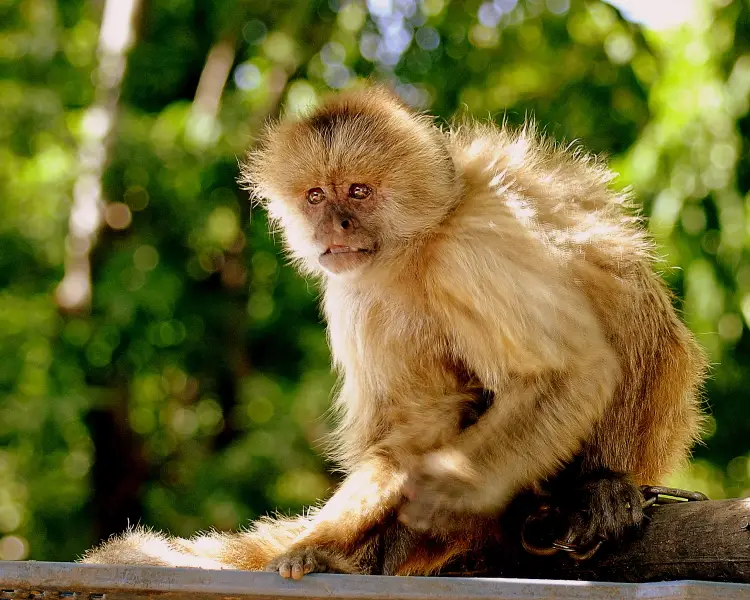
In the ecoregions of Chocó and Tumbes in Ecuador and Peru, only 1% of the original range of the Ecuadorian white-fronted capuchin is still present.
The inhabitants, especially those who reside near corn, banana, cocoa, and plantain plantations, view these monkeys who live in trees as pests.
In mangrove areas, they offer competition for crab hunting. With an unknown number of mature individuals, this animal is classified as highly endangered.
Scientific Name
Cebus aequatorialis
Current Population
There are currently just 300 Ecuadorian White-Fronted Capuchins in the wild.
Reasons Why They Are Endangered
Since Cebus aequatorialis has been subject to numerous dangers for a long time, it is currently considered as an endangered species. They frequently face dangers like Grazing, fragmenting of the habitat, Unlawful mining, anthropogenic elements, and deforestation.
Status of Conservation
Ecuadorian capuchins are a critically endangered species.
| Scientific Name | Current Population | Reasons for Endangerment | Conservation Status |
|---|---|---|---|
| Cebus aequatorialis | 300 | Grazing, habitat fragmentation, illegal mining, anthropogenic elements, deforestation | Critically Endangered |
5. Tapanuli Orangutan
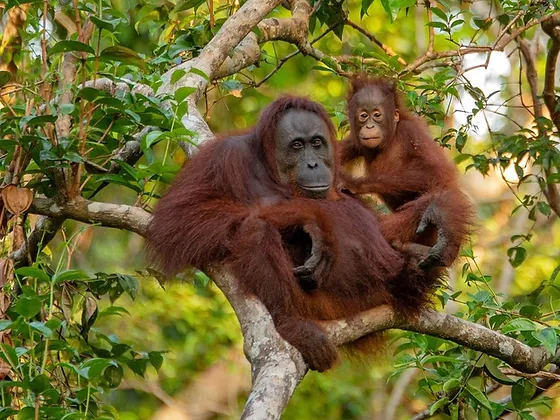
The severely endangered Tapanuli orangutan was legally recognized as a distinct species in 2017. It was previously believed to be the southernmost population of Sumatran orangutans. Due to habitat destruction brought on by unlawful logging and trafficking for the pet trade.
Since these tree-dwelling monkeys seldom descend to the ground, a proposed hydroelectric dam poses a threat to the remaining population. They are unable to move between different parts of the forest because of roads that split the trees.
The severely endangered Tapanuli orangutan was legally recognized as a distinct species in 2017. It was previously believed to be the southernmost population of Sumatran orangutans.
Due to habitat destruction brought on by unlawful logging and trafficking for the pet trade. Since these tree-dwelling monkeys rarely come to the ground, a proposed hydroelectric dam poses a threat to the remaining population.
They are unable to move between different parts of the forest because of roads that split the trees.
Scientific Name
Pongo tapanuliensis
Current Population
In accordance with an IUCN report from 2018, there are just 800 Tapanuli orangutans left.
Reasons Why They Are Endangered
Because of specific risks such as illegal wildlife trade, poaching, habitat loss, human conflict, mining, projected dam construction, and hydropower project, this highly rare great primate is becoming endangered.
Status of Conservation
The Tapanuli orangutan is currently considered a highly endangered species.
| Scientific Name | Current Population | Reasons for Endangerment | Conservation Status |
|---|---|---|---|
| Pongo tapanuliensis | 800 | Illegal wildlife trade, poaching, habitat loss, human conflict, mining, dam construction, hydropower projects | Critically Endangered |
6. Western Chimpanzee
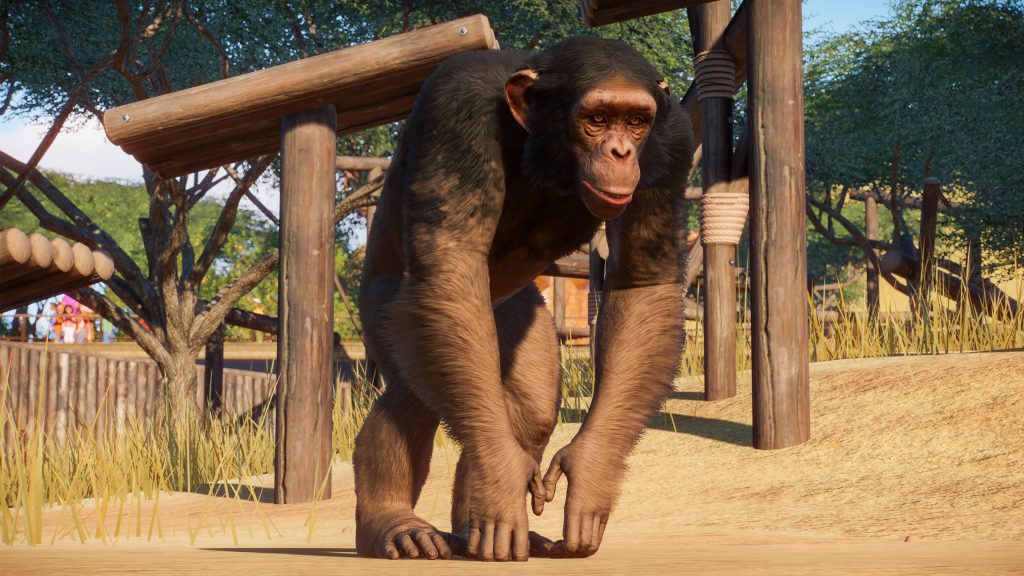
The population of western chimpanzees, which may be found in the rainforest and savannah woodland of Côte d’Ivoire, Ghana, Guinea-Bissau, Liberia, Mali, Republic of Guinea, Senegal, and Sierra Leone, decreased by an estimated 80% between 1990 and 2014. At this rate, IUCN believes by 2060, 99 percent of the remaining western chimpanzees will be gone.
Scientific Name
Pan troglodytes verus
Current Population
Although it is listed as severely endangered, the present population is thought to number between 35,000 and 55,000 individuals.
Reasons Why They Are Endangered
Illegal hunting is the main danger to western chimpanzees
Status of Conservation
Western Chimpanzee is currently considered a highly endangered species.
| Scientific Name | Current Population | Reasons for Endangerment | Conservation Status |
|---|---|---|---|
| Pan troglodytes verus | 35,000 – 55,000 | Illegal hunting | Critically Endangered |
7. Hainan Gibbon
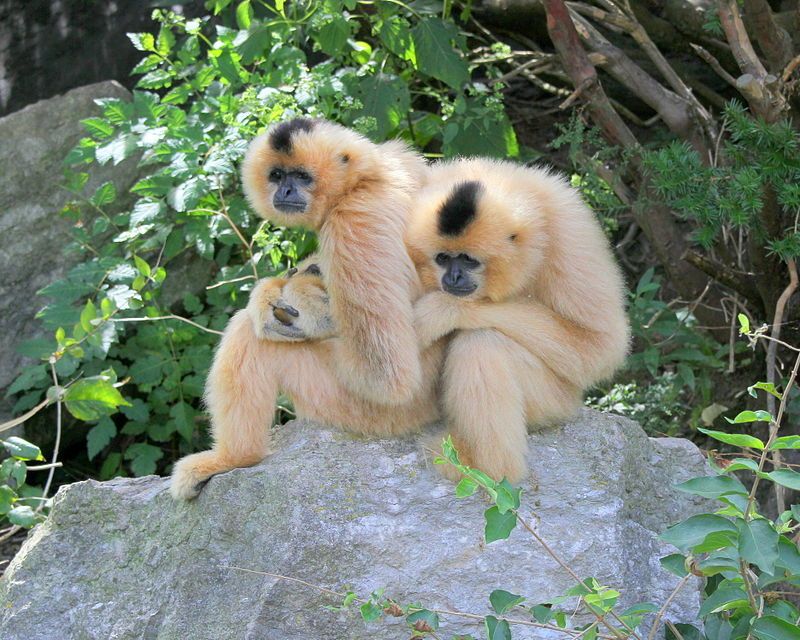
The Hainan gibbon is the rarest species of ape, monkey, and perhaps mammal on the entire planet. Due to habitat degradation and hunting, the Hainan gibbon suffered a significant decrease in the late 20th century and is currently one of the most threatened species in the world.
On China’s Hainan Island’s Bawangling National Nature Reserve, a single forest patch is the only place where the last remaining population may be found. The remaining populations of the island are believed to have vanished for more than 20 years.
Scientific Name
Nomascus hainanus
Current Population
In the 1980s, there were less than 10 individuals still living there; by 2021, that number had increased to 35.
Reasons Why They Are Endangered
The Hainan gibbon has become endangered and threatened because of Hunting, loss of habitat, and pet trade.
Status of Conservation
The IUCN has given the Hainan gibbon, the rarest primate in the world and the most vulnerable gibbon species, the status of Critically Endangered.
| Scientific Name | Current Population | Reasons for Endangerment | Conservation Status |
|---|---|---|---|
| Nomascus hainanus | 35 | Hunting, habitat loss, pet trade | Critically Endangered |
8. Northern Sportive Lemurs
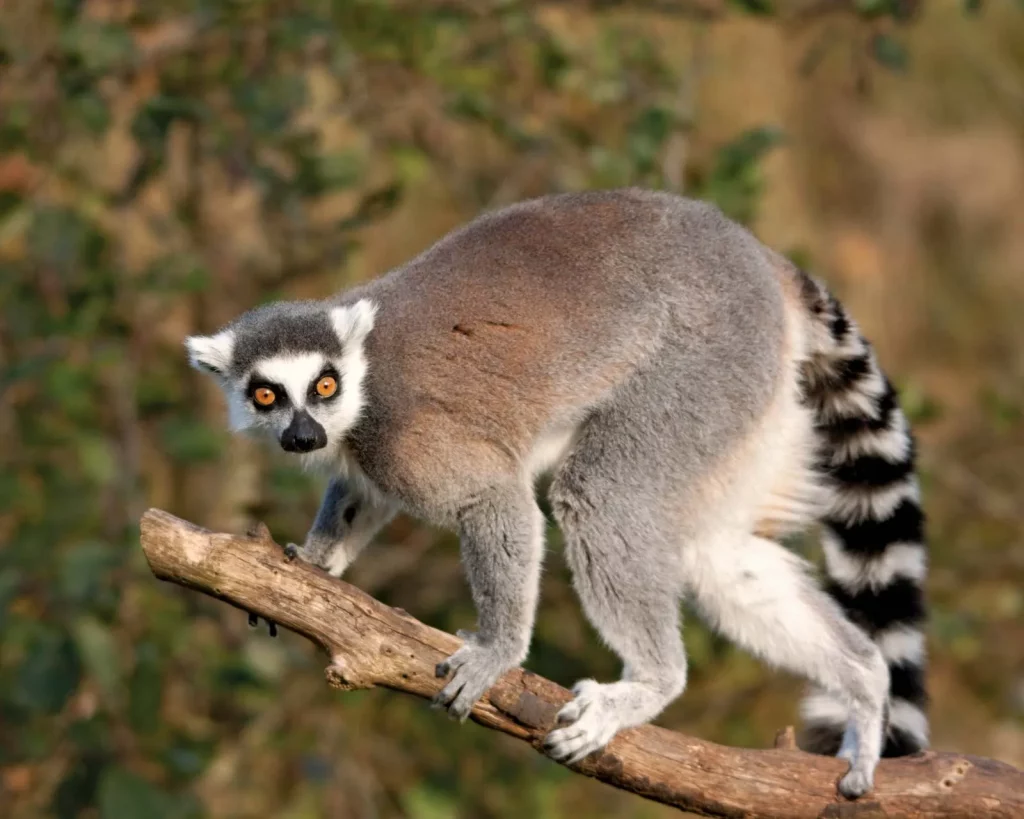
Also known as northern weasel lemurs or Sahafary sportive lemurs, these lemurs are well-known. Originally from Northern Madagascar, sportive lemurs. Small patches of deciduous forests north of the Irodo River, close to Andrahona, and nearby the Sahafary villages of Ankarongana and Madirobe make up this primate’s natural habitat.
The Northern sportive lemurs may have an impact on the trees they use due to their folivorous diet. They also play a significant role in the food chain of their habitat as prey for native boa predators.
Scientific Name
Lepilemur septentrionalis
Current Population
There are just 50 to 70 Sahafary sportive lemurs left in existence.
Reasons Why They Are Endangered
the most significant threats to Northern Sportive Lemurs are Natural habitat destruction and illegal hunting.
Status of Conservation
The northern weasel lemur is listed as a critically endangered species on the IUCN Red List.
| Scientific Name | Current Population | Reasons for Endangerment | Conservation Status |
|---|---|---|---|
| Lepilemur septentrionalis | 50-70 | Habitat destruction, illegal hunting | Critically Endangered |
9. Gaoligong Hoolock Gibbon
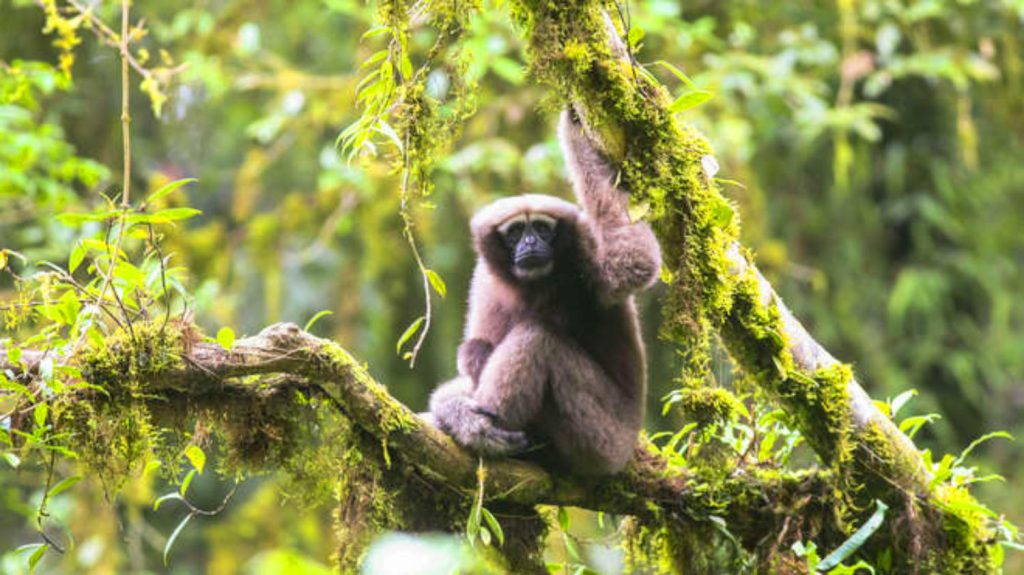
Originally, the Gaoligong Gibbon, also known as the Skywalker Gibbon, was thought to be the Eastern Hoolock Gibbon’s most eastern population. In 2017, based on the peculiarities in its genetic makeup and morphology, it was classified as a separate species. Only three locations in Yunnan Province, Baoshan, Tengchong, and Yingjiang, are home to the Gaoligong Gibbon in China.
Male and female mature Skywalker hoolock gibbons look different from one another. The adult male Gaoligong Gibbons are black, while the adult females are buffy brown with light-colored crowns. However, the unique characteristic of this species is the color of their eyebrows, which are white.
Scientific Name
Hoolock leuconedys
Current Population
The most recent survey found that isolated subpopulations in China only contain about 150 individuals.
Reasons Why They Are Endangered
The several factors that put them at danger include habitat loss, illegal hunting, deforestation, and pet trafficking.
Status of Conservation
This primate species is on the endangered species list.
| Scientific Name | Current Population | Reasons for Endangerment | Conservation Status |
|---|---|---|---|
| Hoolock leuconedys | 150 | Habitat loss, illegal hunting, deforestation, pet trafficking | Endangered |
10. Bemanasy Mouse Lemur
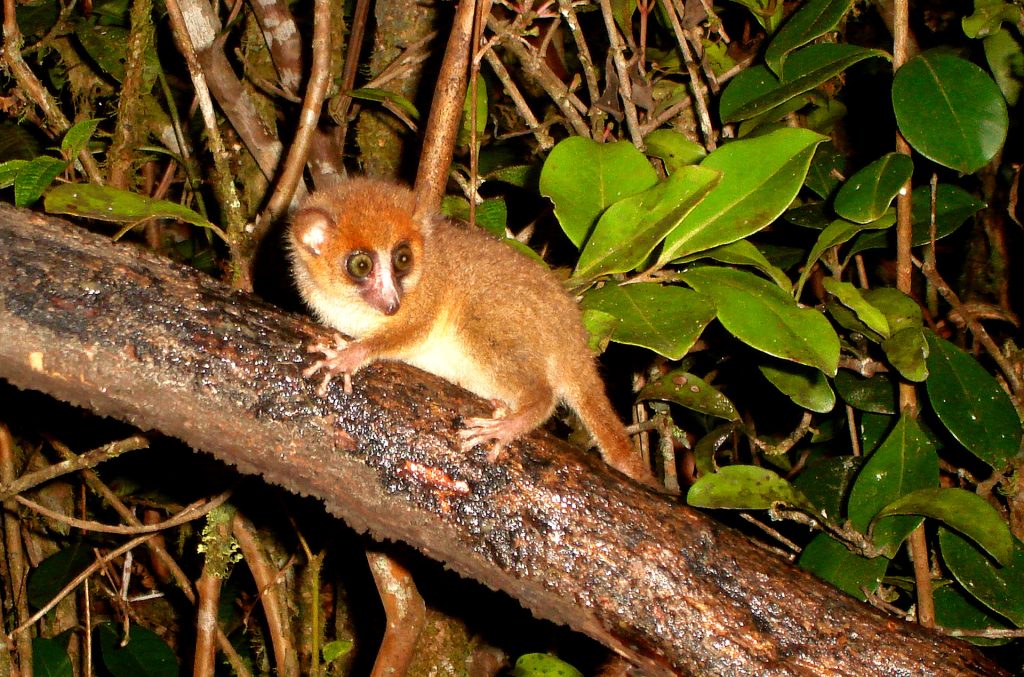
The Bemanasy mouse lemur lives in a patch of forest in southeast Madagascar. It was identified as a distinct species in 2016.
This species of mouse lemur is the largest of all of them. There is a greyish-brown coat that appears on their tail and back. The many species of mouse lemurs are thought to be cryptic species, differing very slightly morphologically but differing greatly genetically.
Recent data suggests that these calls, which are extremely varied, differ from one another. Since mouse lemurs are nocturnal animals, it is possible that they did not evolve distinct facial features but rather a variety of hearing and vocal systems.
Scientific Name
Current Population
The precise number of this species’ remaining individuals is unknown, but it is extremely low.
Reasons Why They Are Endangered
The Bemanasy Mouse Lemur is a different primate that is in risk of extinction as time goes on, and the main factors affecting its population decline include logging and slash-and-burn agriculture.
Status of Conservation
It is a highly endangered primate that is in risk of going extinct.
| Scientific Name | Current Population | Reasons for Endangerment | Conservation Status |
|---|---|---|---|
| Microcebus manitatra | Unknown | Logging, slash-and-burn agriculture | Critically Endangered |
11. Caquetá Titi Monkey
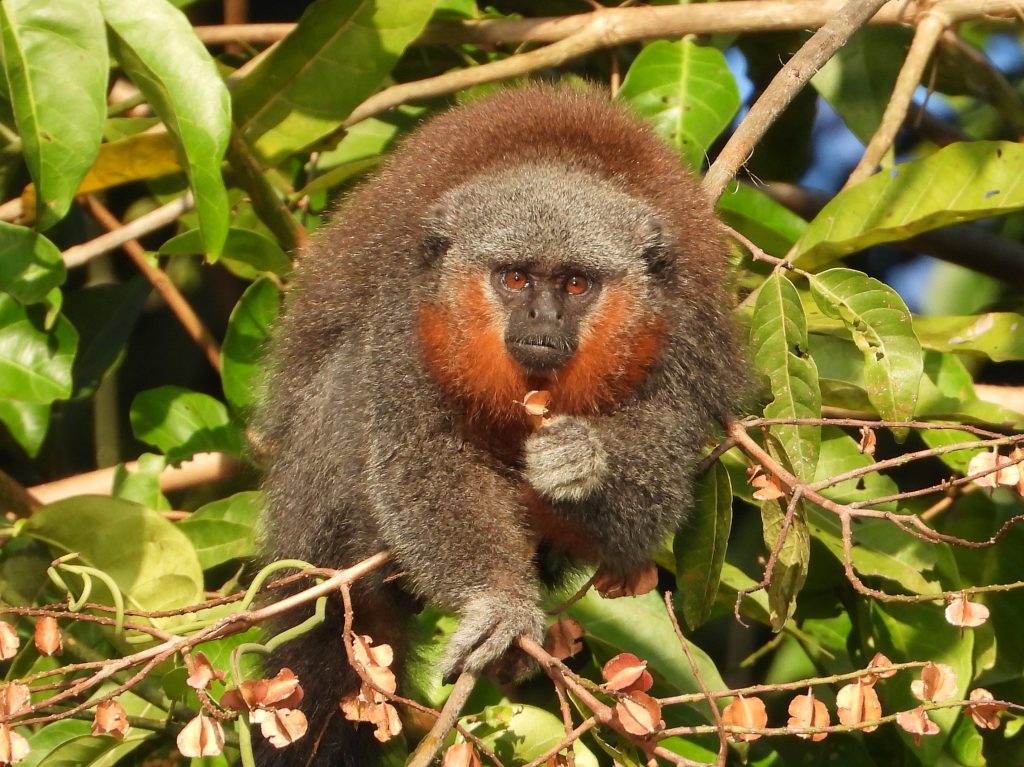
Caquetá Titi Monkeys have a unique song, purr like kittens, and form monogamous relationships. These stunning and interesting monkeys, who were just recently discovered in 2010, are now in grave danger due to the extensive deforestation taking place in Colombia for palm oil and other commodities. Caquetá Titi Monkeys have been spotted in disturbed, humid, tropical lowland forest fragments on terra firm, frequently surrounded by pasturelands and on low swampy ground.
Scientific Name
Plecturocebus caquetensis
Current Population
Less than 50 mature Caquetá Titi Monkeys is estimated to remain in the wild, out of a total population of less than 100.
Reasons Why They Are Endangered
This species is classified as Critically Endangered due to a population decline that has been estimated to be more than 80% over 24 years, as a result of a decrease in the area that it can occupy as a result of extensive ranching and illegal crop cultivation. These factors are undoubtedly still at play.
Status of Conservation
It was listed as a critically endangered primate by IUCN.
| Scientific Name | Current Population | Reasons for Endangerment | Conservation Status |
|---|---|---|---|
| Plecturocebus caquetensis | < 50 (out of < 100 total) | Ranching, illegal crop cultivation | Critically Endangered |
12. Gray-Shanked Douc Langur
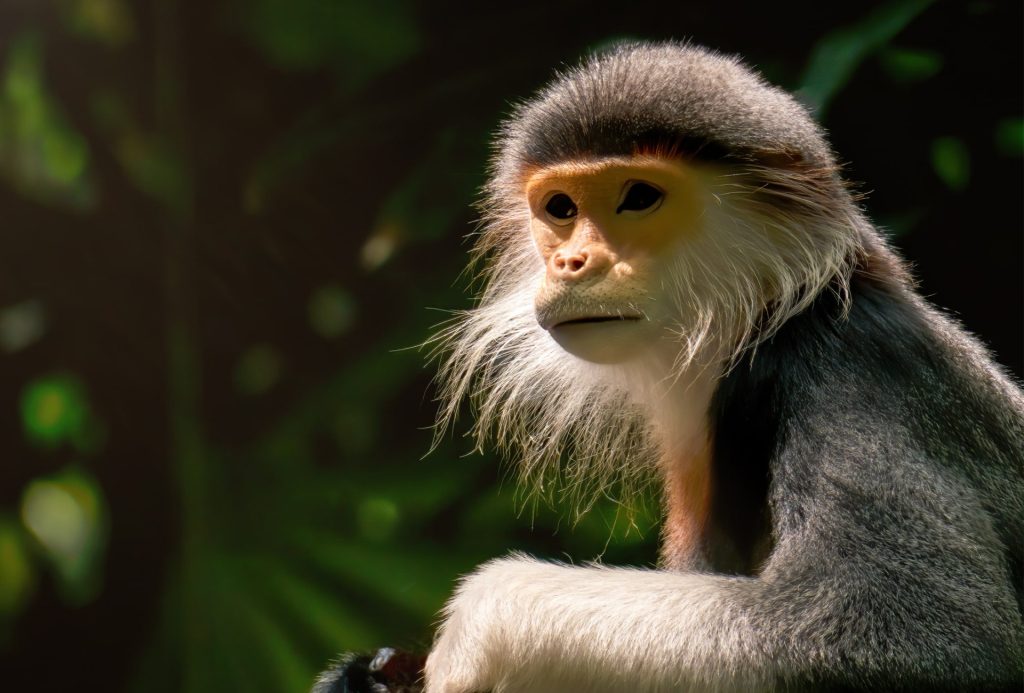
The Qung Ngi, Qung Nam, Kon Tum, Bnh nh, and Gia Lai provinces of Vietnam are home to the grey-shanked douc. The Frankfurt Zoological Society’s Vietnam Primate Conservation Program and the Endangered Primate Rescue Center at Cuc Phuong National Park have done surveys and studies on this recently discovered primate.
The Grey-Shank Initially, it was thought that Central Vietnam was home to an endemic species of the douc langur. Recently, it was determined that the species is also present in northeastern Cambodia and southeast Laos.
Scientific Name
Pygathrix cinerea
Current Population
Gray-Shanked Douc had a population of between 550 and 700 in 2004, however it was noted in 2016 that there were now 1000 of them.
Reasons Why They Are Endangered
The pet trade and hunting for traditional medicine are the greatest dangers to this species.
Status of Conservation
According to the 2007 Vietnam Red Data Book, the species is Critically Endangered in Vietnam.
| Scientific Name | Current Population | Reasons for Endangerment | Conservation Status |
|---|---|---|---|
| Pygathrix cinerea | 1000 | Pet trade, hunting for traditional medicine | Critically Endangered (in Vietnam) |
13. Indri
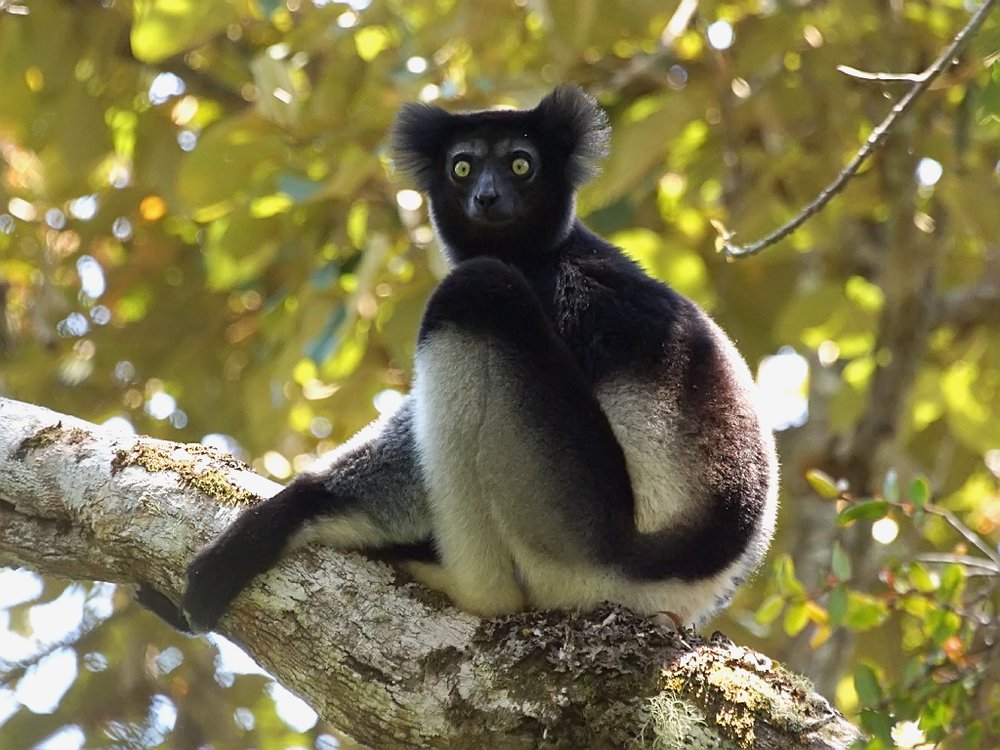
Indris are lemurs that are unique to the island of Madagascar. Due to its unusual terrain, this vast island is a vivid tapestry of various temperatures and distinctive ecosystems.
The Indris live in the luxuriant tropical jungles that line this island’s eastern shore. The ground here descends toward the coast from the rugged central highlands. Although groups can occasionally be seen at higher elevations, indris mainly prefer woodlands at low to mid-elevations.
Scientific Name
Indri indri
Current Population
The remaining population of this primate is estimated to be 1,000–9,000 individuals, according to research.
Reasons Why They Are Endangered
Most of the population decline among Indri is caused by logging, illegal hunting, fragmentation, and habitat damage.
Status of Conservation
According to the International Union for Conservation of Nature, Indri is one of the world’s most endangered primates.
| Scientific Name | Current Population | Reasons for Endangerment | Conservation Status |
|---|---|---|---|
| Indri indri | 1,000-9,000 | Logging, illegal hunting, habitat fragmentation, habitat damage | Critically Endangered |
14. Tonkin Snub-Nosed Monkey
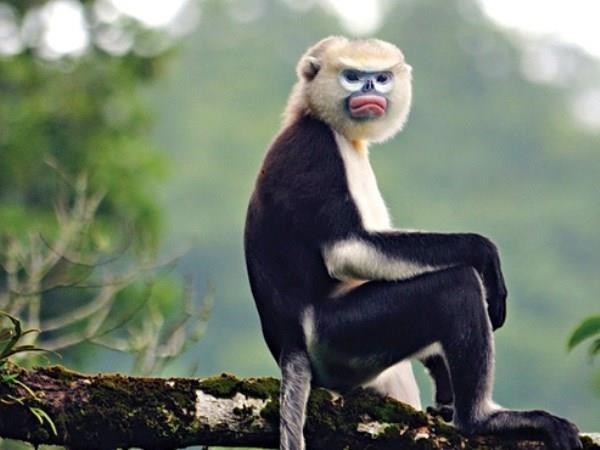
The Tonkin snub-nosed monkey, which is only present in a few isolated forest remnants among the karst limestone hills of northern Vietnam, is one of the most endangered primates on the planet.
The Tonkin snub-nosed monkey is an endangered species whose range has been reduced to just a few locations, and the numbers at most of these have been decreasing dramatically.
It lives in extended family groups made up of an adult male, several females, and their offspring, who frequently gather together to sleep or feed. However, sightings of this species are becoming increasingly rare.
Scientific Name
Rhinopithecus avunculus
Current Population
There are estimated to be only 200 individuals left in the wild of this native to northern Vietnam species.
Reasons Why They Are Endangered
Like so many other Vietnamese primates, habitat degradation and hunting are the greatest dangers to its existence. The body parts of this monkey have also been ruthlessly sought, not just for bushmeat but also to meet the demand for traditional medicine.
Status of Conservation
The protection of the highly endangered Tonkin snub-nosed monkey is a top priority worldwide.
| Scientific Name | Current Population | Reasons for Endangerment | Conservation Status |
|---|---|---|---|
| Rhinopithecus avunculus | 200 | Habitat degradation, hunting, demand for traditional medicine | Critically Endangered |
15. Aye-Aye
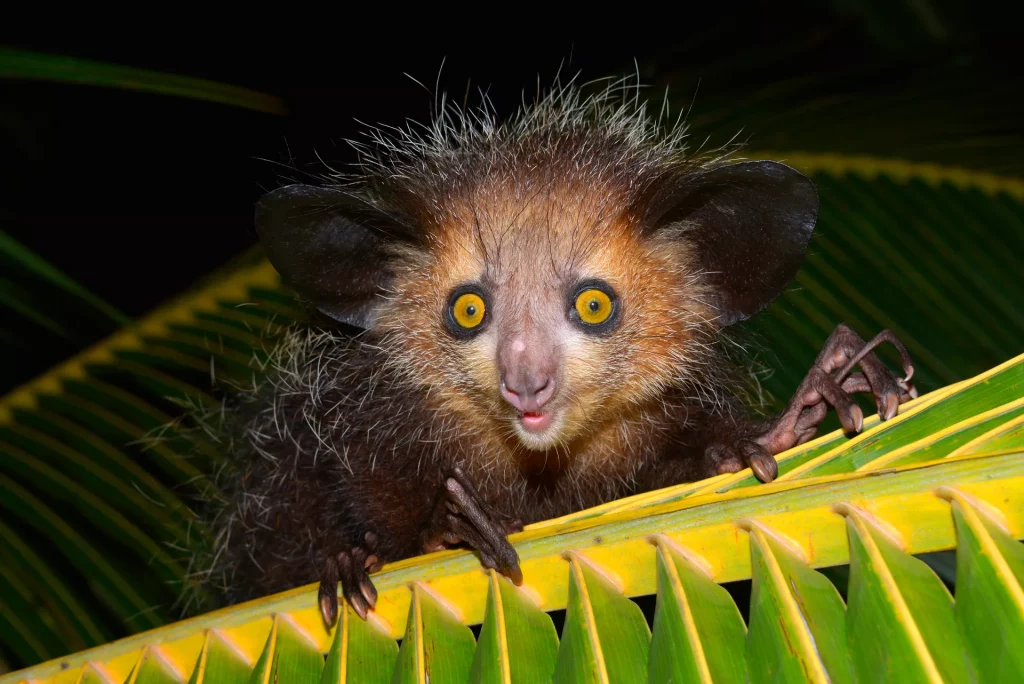
The aye-aye has the largest geographic range of any lemur due to their ability to eat a variety of foods. Percussive foraging is the process through which an aye-aye finds grubs by tapping on trees with its extended middle finger.
The only ape that employs this type of echolocation to locate food is the aye-aye.
The aye-aye is seen as a bad omen by many natives of Madagascar. They have frequently been shot dead right away because of this. Aye-aye populations are in danger as a result of such hunting and habitat loss. They are currently covered by the legislation.
Scientific Name
Daubentonia madagascariensis
Current Population
Aye-aye populations range from 1,000 to 10,000 worldwide, and they are not considered to be critically endangered.
Reasons Why They Are Endangered
The main threat to the endangered aye-ayes population is poaching.
Status of Conservation
Aye-aye monkeys are listed as endangered by the IUCN.
| Scientific Name | Current Population | Reasons for Endangerment | Conservation Status |
|---|---|---|---|
| Daubentonia madagascariensis | 1,000-10,000 | Poaching | Endangered |
16. Golden-headed Langur
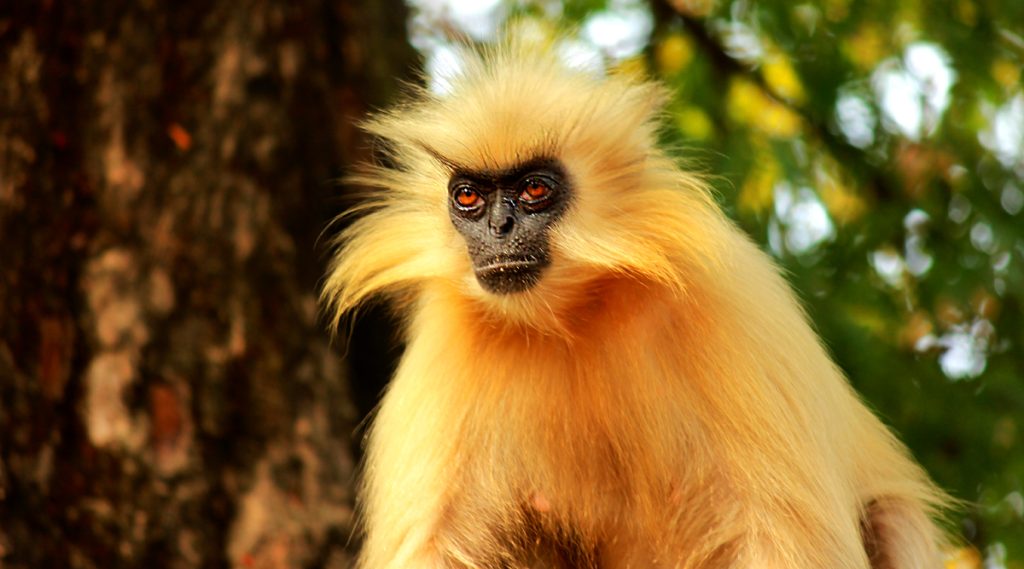
Another popular name for the Golden-headed langur is Cat Ba langur. The Cat Ba Langur inhabits the karst hills’ forests. They are mostly folivorous, with shoots, fruit, flowers, and bark making up the remaining 60–80% of their diet. Although group size varies, it typically includes of one adult male, many females, and young.
Scientific Name
Trachypithecus poliocephalus
Current Population
Unfortunately, there are only around 70 of this rare monkey, the Golden-headed langur, left in the world.
Reasons Why They Are Endangered
The huge decrease in the overall population of Cat Ba langurs was caused by a number of specific threats, including hunting, habitat fragmentation, such as construction for tourists and human intrusion
Status of Conservation
The IUCN has listed the cat Ba langur as a threatened species.
| Scientific Name | Current Population | Reasons for Endangerment | Conservation Status |
|---|---|---|---|
| Trachypithecus poliocephalus | 70 | Hunting, habitat fragmentation, tourism construction, human intrusion | Threatened |
17. Rondo Dwarf Galago
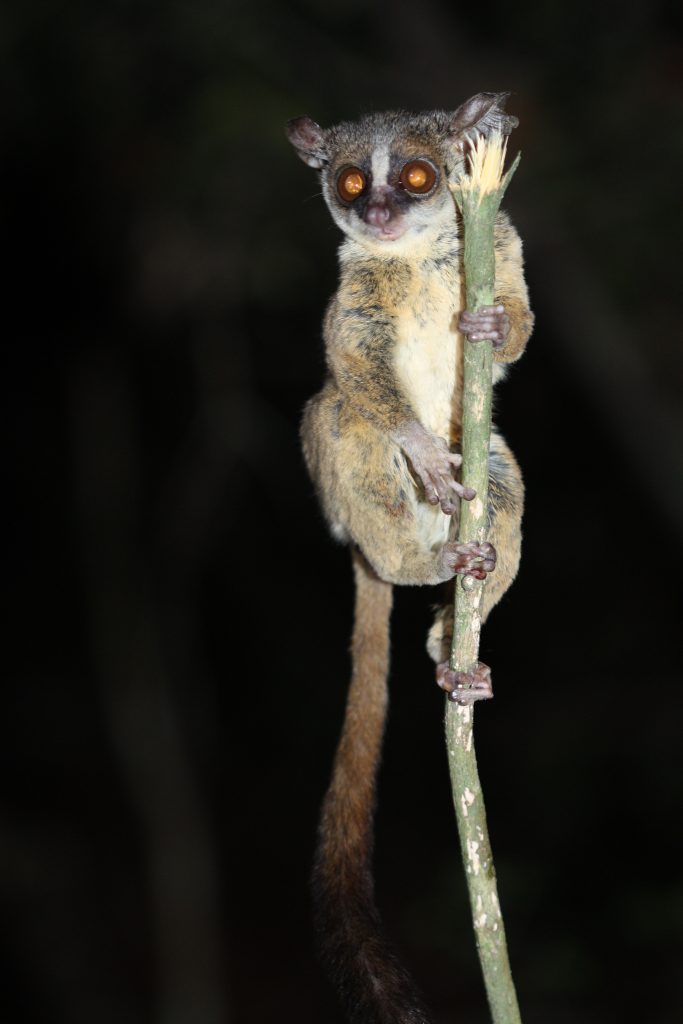
The Rondo dwarf galago is often referred to as the Rondo bushbaby. A species of ape belonging to the Galagidae family is the Rondo dwarf galago. The tiniest members of the genus Galagoides are the dwarf galagos. It only exists in Tanzania, where subtropical or tropical dry woods are its natural habitat. Its habitat is threatened by logging, which has reduced the region where it dwells to less than 100 square kilometers.
Scientific Name
Paragalago rondoensis
Current Population
Although the precise number of Rondo bushbabies in existence is unknown at this time, it is declining with time.
Reasons Why They Are Endangered
The Rondo bushbaby is mostly at risk from hunting and the destruction of natural habitat due to logging
Status of Conservation
It is counted as one of the world’s most endangered primates.
| Scientific Name | Current Population | Reasons for Endangerment | Conservation Status |
|---|---|---|---|
| Paragalago rondoensis | Unknown | Hunting, habitat destruction due to logging | Critically Endangered |
18. Eastern Black Crested Gibbon

The Eastern black crested gibbon is also known as the Cao-vit crested gibbon or Cao-vit black crested gibbon. Southeast China and Northern Vietnam are the most typical locations for seeing eastern black crested gibbons. It prefers the subtropical region’s steep terrain and deciduous, semi-evergreen, and evergreen forests.
Scientific Name
Nomascus nasutus
Current Population
There are now less than 250 mature Eastern black crested gibbons left.
Reasons Why They Are Endangered
The Cao-Vit crested gibbon is now considered to be highly endangered due to deforestation, hunting, encroachment.
Status of Conservation
It is also one of the rarest species of primate and is critically endangered.
| Scientific Name | Current Population | Reasons for Endangerment | Conservation Status |
|---|---|---|---|
| Nomascus nasutus | < 250 | Deforestation, hunting, encroachment | Critically Endangered |
19. Perrier’s Sifaka

Madagascar is home to the rare Perrier’s sifaka. They live specifically in Madagascar’s northeastern semi-humid or dry deciduous woodlands.
It was once thought to be a subspecies of the Diademed Sifaka. Its habitat is dry deciduous or semihumid forest, and it has a very narrow distribution in northeastern Madagascar. Its range includes protected areas in some parts. It moves in little families.
Scientific Name
Propithecus perrieri
Current Population
There are only 500 Perrier’s sifaka left in existence.
Reasons Why They Are Endangered
The main factors contributing to the Perrier’s sifaka being a severely endangered primate are habitat fragmentation and devastation brought on by logging, charcoal collecting, and slash-and-burn practices.
Status of Conservation
The Perrier’s sifaka is listed as critically endangered by the IUCN.
| Scientific Name | Current Population | Reasons for Endangerment | Conservation Status |
|---|---|---|---|
| Propithecus perrieri | 500 | Habitat fragmentation and destruction due to logging, charcoal collecting, and slash-and-burn practices | Critically Endangered |
20. The White-thighed Colobus

The white-thighed colobus, which ranges from the Ivory Coast’s region between the Sassandra and Bandama Rivers to Benin and potentially into southwestern Nigeria, has a dispersed distribution in eastern Africa.
Adults have a tail that is totally white and are predominantly black with white markings on their thighs and faces. Colobus pups are born with completely white fur that gradually darkens over the course of three months.
Scientific Name
Colobus vellerosus
Current Population
There are estimated to be less than 1,200 inhabitants exist right now.
Reasons Why They Are Endangered
This animal is critically endangered, and unrestricted hunting is causing its population to quickly decline.
Status of Conservation
The white-thighed colobus is listed as endangered primate species by the IUCN.
| Scientific Name | Current Population | Reasons for Endangerment | Conservation Status |
|---|---|---|---|
| Colobus vellerosus | < 1,200 | Unrestricted hunting | Endangered |
21. Pig-Tailed Snub-Nose Langur
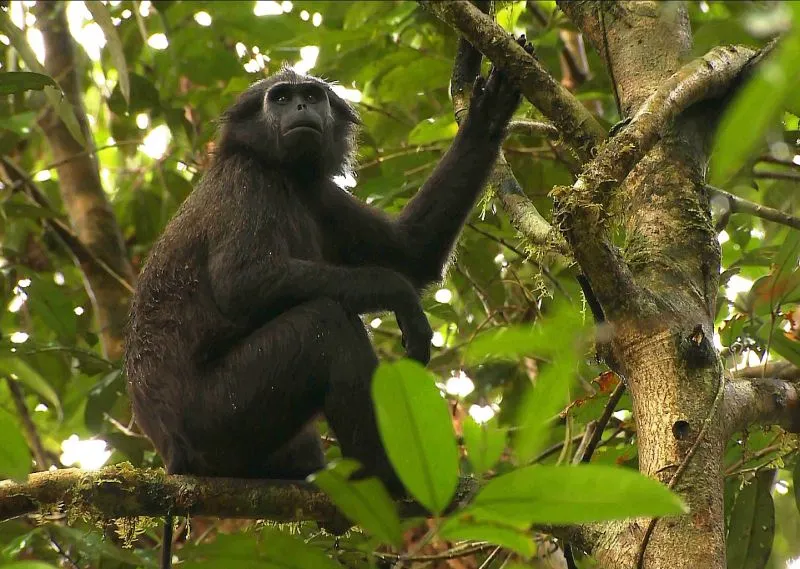
The pig-tailed snub-nosed monkey descends to the ground when threatened and lives in the primary forest, where it is mostly arboreal. Mostly leaves and a few fruits and berries make up its diet.
Most social groups that can be seen are small (3-8 monkeys). These could be monogamous groupings made up of a parent pair and their child or harem groups with multiple adult females.
Scientific Name
Simias concolor
Current Population
There are estimated to be less than 3,347 inhabitants exist right now.
Reasons Why They Are Endangered
This species as well as other primates that live in the woodlands cannot survive there because of the soil and tree damage. Additionally, it facilitates the hunting of the prized meat-producing pig-tailed snub-nosed langur. On the new logging roads, hunters shoot the monkey with rifles from the safety of their cars.
Status of Conservation
The pig-tailed snub-nosed monkey is listed as endangered primate species by the IUCN.
| Scientific Name | Current Population | Reasons for Endangerment | Conservation Status |
|---|---|---|---|
| Simias concolor | < 3,347 | Habitat destruction, hunting | Endangered |
22. Rollaway Monkey
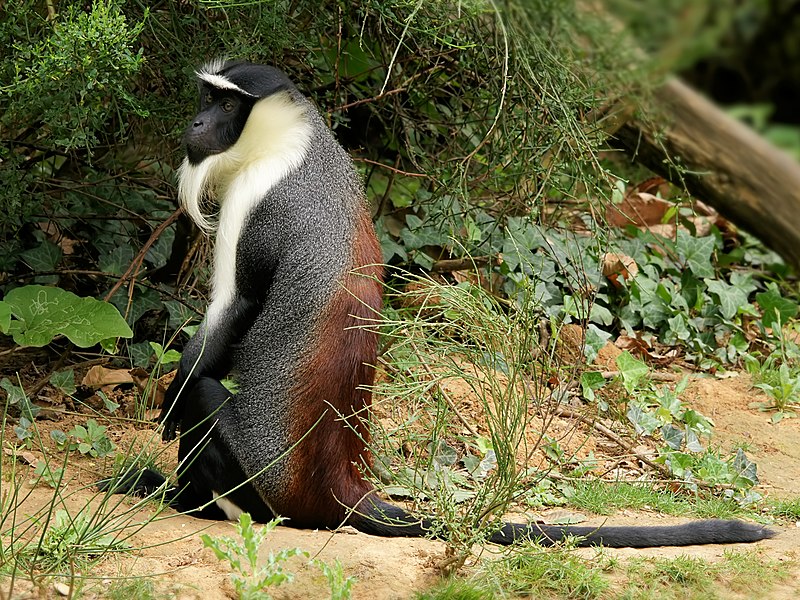
Tropical West Africa is the natural habitat of the Rollaway monkey. It can be found in the forests of Ghana, Togo, Burkina Faso, and the eastern ivory coast.
Because the Roloway monkey has so many locations to hide, view, and escape, its natural habitat is considered complicated.
Scientific Name
Cercopithecus roloway
Current Population
Only 300 Roloway monkeys remain in the wild due to the environment’s adverse effects.
Reasons Why They Are Endangered
The main causes of their extinction on our planet are the loss of their natural habitat and hunting.
Status of Conservation
The Roloway monkey is considered a highly endangered primate.
| Scientific Name | Current Population | Reasons for Endangerment | Conservation Status |
|---|---|---|---|
| Cercopithecus roloway | 300 | Habitat loss, hunting | Critically Endangered |
23. Greater Bamboo Lemur
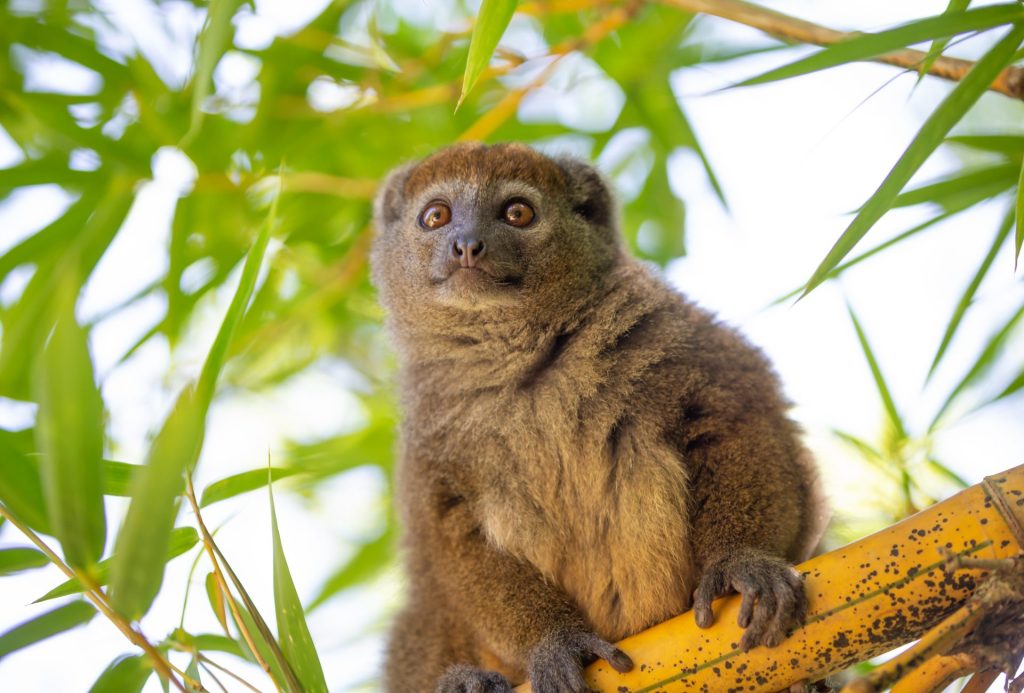
Broad-nosed gentle lemur and broad-nosed bamboo lemur are some alternate names for the Greater Bamboo Lemur.
The Greater bamboo lemur lives on Madagascar’s island of Southeast. This species today resides in about 1 to 4% of its historical habitat, despite subfossil evidence suggesting they originally had a large distribution including the northern, northwestern, central, and eastern regions of Madagascar.
Greater bamboo lemurs are mostly restricted to the Ranomafana National Park’s protected regions, which are found in southeast Madagascar.
Scientific Name
Prolemur simus
Current Population
20 broad-nosed bamboo lemurs are kept in captivity and 100 to 160 are still found in their native environment.
Reasons Why They Are Endangered
Scientists believe that deforestation, slash-and-burn farming, and the effects of climate change on the Greater Bamboo Lemur’s teeth are reasonable explanations for the species’ population decline.
Status of Conservation
The number of endangered primates is constantly declining, including the broad-nosed gentle lemur.
| Scientific Name | Current Population | Reasons for Endangerment | Conservation Status |
|---|---|---|---|
| Prolemur simus | 100-160 (in wild); 20 in captivity | Deforestation, slash-and-burn farming, climate change effects on teeth | Endangered |
24. Kipunji
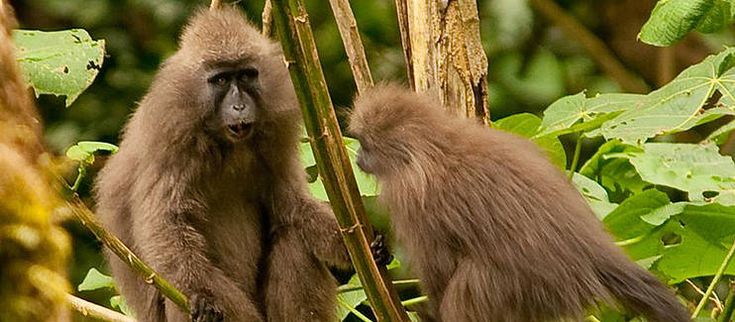
The kipunji, which was only recently found in 2003, only inhabits the mountain ecosystems near Tanzania’s Mount Rungwe. They have a distinctive, powerful, low-pitched honk-bark that is very distinctive. The area’s flagship species for conservation work is the kipunji.
Scientific Name
Rungwecebus kipunji
Current Population
Despite the fact that 1,117 individuals in 38 groups still exist, there have been significant advances in habitat restoration.
Reasons Why They Are Endangered
Kipunji populations decrease as these forests become more fragmented. Their likelihood of survival has been sharply reduced by this trend. Additionally, humans illegally hunt kipunjis, frequently as revenge for raiding farmers’ crops.
Status of Conservation
The International Union for Conservation of Nature (IUCN) Red List of Threatened Species presently lists the kipunji as Endangered.
| Scientific Name | Current Population | Reasons for Endangerment | Conservation Status |
|---|---|---|---|
| Rungwecebus kipunji | 1,117 (in 38 groups) | Habitat fragmentation, illegal hunting | Endangered |
25. Niger Delta Red Colobus
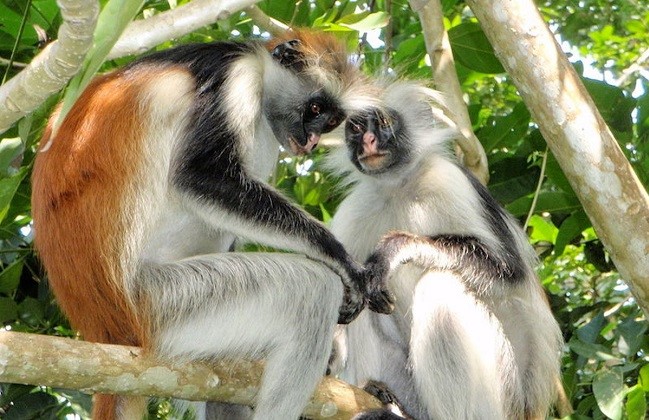
One of the most secretive and seriously endangered primates in Africa is the red colobus, which is restricted to the western Niger Delta and the high canopies of these forests.
Nigeria’s forested marshland between the Forcados-Nikrogha Creek and the Sagbama-Osiama-Agboi Creek is home to the Niger Delta red colobus. This was regarded as a subspecies until 2008.
Scientific Name
Piliocolobus epieni
Current Population
Only 500 Niger Delta red colobus remain in the wild due to the environment’s adverse affects.
Reasons Why They Are Endangered
The area’s instability has intensified habitat loss while hunting pressures on the population have caused this species to plummet to an estimated few hundred individuals.
Status of Conservation
The severely endangered red colobus of the Niger Delta is actually at risk of going extinct.
| Scientific Name | Current Population | Reasons for Endangerment | Conservation Status |
|---|---|---|---|
| Piliocolobus epieni | 500 | Habitat loss, hunting | Critically Endangered |
Hugues Beaufrere is the Exoticpetia’s senior writer and reptile expert. He has been fascinated by reptiles and monkeys since he was a kid and had years of experience in herpetology and primatology. He has cared for various kinds of Monkeys, Lizards and Reptiles and loves to share his knowledge and passion with others.


